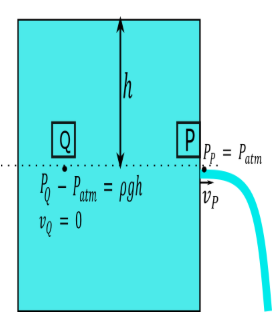Question
Question: A leakage begins in the water tank at position P as shown in the figure. The initial gauge pressure ...
A leakage begins in the water tank at position P as shown in the figure. The initial gauge pressure at P was 5×105N/m2 .if the density of water is 1000kg/m3 the initial velocity with which water gushes out is:

A) 3.2m/sec
B) 32m/sec
C) 28m/sec
D) 2.8m/sec
Solution
To solve this question we use Bernoulli’s theorem which is P1+21ρv12+ρgh1=P2+21ρv22+ρgh2
And we know the gauge pressure is pressure above that of the atmospheric pressure at that point can be represented as P−Patm=ρgh .
Where P⇒ is the total pressure at that point or at that level
Step by step solution:
First we mark another point Q at the same level of P let as assume the point P and Q are h height below the free surface of the water tank.
As shown in figure.

From figure we can write the gauge pressure at point Q is PQ−Patm=ρgh
Where ρ⇒ density of water
PQ⇒ Total pressure at point Q
h⇒ Height from free surface
So from this we can Wright the pressure at point Q is
⇒PQ=Patm+ρgh ......... (1)
Pressure at point P is equal to the atmospheric pressure
PP=Patm ......... (2)
Velocity at point Q is approximately equal to zero
vQ=0....... (3)
Let us assume the velocity at point P is with which water comes out is vP
Step 2
Now we apply Bernoulli’s theorem for horizontal points P and Q.
⇒PP+21ρvP2+ρghP=PQ+21ρvQ2+ρghQ
Because point P and Q are at same horizontal level hP=hQ so Bernoulli theorem reduced to
⇒PP+21ρvP2=PQ+21ρvQ2
Put all values in this equation from (1) (2) and (3)
⇒Patm+21ρvP2=(Patm+ρgh)+21ρ(0)2
⇒21ρvP2=ρgh
Now PQ−Patm=ρgh=5×105N/m2 given in question
Put ρgh=5×105 and density of water ρ=1000kg/m3
⇒21×1000×vP2=5×105
⇒vP2=10005×105×2
Further solving
⇒vP=10005×105×2
⇒vP=1000
⇒vP=31.62m/sec
Hence the velocity to exit the water tank at point P is approximately 32m/sec
therefore Option B is correct
Note:
We can solve this question by another short method which is given below
We know gauge pressure P=ρgh from this we can find height of hole from free surface
⇒5×105=1000×10×h ⇒h=50m
And now apply Torricelli’s theorem formula velocity of Efflux v=2gh
⇒v=2×10×50 ⇒v=1000 ∴v=31.62m/sec
